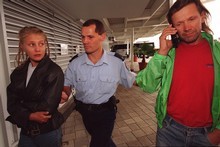

MAKING SNARK
Brand new SDGNZ member Stephen Sinclair talks about making his feature film directorial debut, Russian Snark, which opened nationwide on 16 June.
What was the inspiration for Russian Snark?
Having directed for the theatre for many years, and made several short films, I felt it was time to tackle a feature. I’d made a short film, Russian Doll, with actors Elena Stejko and Stephen Papps five or six years ago, and thought they were really great together, so I set about creating a longer form story for them to star in. I remembered the news story of the two Russians who floated out to New Zealand in a modified life boat in 1998, and thought this could make a perfect vehicle for their talents. The story made a real impression at the time – a fairytale of a couple escaping from poverty and inertia in Russia to build a new life in Godzone.
Did you have a clear idea of the story and how it was going to end when you started writing?
No. I made it up as I went along, which I found very liberating. Snark was largely self-funded, although we did get 25k from the Screen Innovation Production Fund and a smaller amount of post-production support from the NZFC, thanks to being accepted to screen at the NZ International Film Festival. The fact we were basically financing it ourselves meant I didn’t have to consult with and please any bureaucrat or businessman. As a result I could be as eccentric as I wanted to be.
Speaking of eccentric, what’s the significance of the title?
Well, it’s an enigmatic title for an enigmatic film! Though I will say it’s a play on the title of the celebrated Russian movie, Russian Ark.
How long did it take from when you came up with the idea to the start of filming?
About eight months, all up. The script itself came together over about six months during 2007-8. As you know, compared to the development time devoted to most movies, this is quite swift.
Do you think the film benefited from coming together so quickly?
Well, it certainly made me focus, and concentrate all my energies on scripting and pre-production. I also went into it feeling I’d fix any narrative issues with pick-ups. In hindsight this was a bit naïve. Ideally you should be able to make films this way, but the commercial realities of the business – not to mention logistics – make it a difficult and expensive way to create a story on film. It’s impractical.
Do you think this approach came from your background as a writer?
Yes, perhaps it is more a writer’s mode of storytelling. As a writer you accept that any story you take on will take numerous drafts to get right. Revision becomes a way of life. In a perfect world, directors too would be able to shoot as much and as often as they wanted.
Do you think there are parallels in the approach you took with the way your brother Harry made his films (Topless Women Talk About Their Lives, The Price of Milk, Toy Love)?
Yes, I think I took my cue from Harry to some extent, though I did more writing up front than he ever did. That’s because I’m a writer first and foremost, and I don’t mind writing – whereas most directors seem to see it as an unpleasant necessity.
So you think NZ directors become writers out of necessity?
This has to be true given the usually high number of writer-directors per capita we have in this country. It’s a pity more people don’t set out to be writers, since the greatest bottleneck in the NZ film industry is the lack of good scripts.
How do you think this could be remedied?
Make it more of a grassroots activity – have competitions in schools and so on, to get more people interested in it in the first instance. We also suffer from a general lack of interest in the arts in this country. The present government doesn’t seem to attach any value to the arts at all.
How does the process of making a feature film compare to writing a play or a novel or a poem?
I love the process of directing. Making Russian Snark was hard work, but certainly no harder than writing a novel. The greatest difference is that directing demands you think visually a great deal more. And it involves working in a social context, rather than spending endless hours by yourself in front of a screen. I must say that making Russian Snark has changed my ambitions somewhat. Film is certainly more of a focus than it used to be and I’d like to direct more.
So what are your particular strengths when it comes to directing?
Because of my background in theatre, I can direct actors and get what I want from them. And – perhaps surprisingly, since I’m basically a wordsmith – I have a good eye in terms of the composition of shots and so on.
What did you enjoy most about making Russian Snark? And least?
The worst part was pre-production – the stress of casting and assembling the crew and finding locations etc etc. Once the camera started rolling it was a huge relief. And in fact the shoot itself was the most enjoyable part. Someone once remarked that making a movie is the most fun you could have with your pants on – or, in the case of my actors, with their pants off!
Did you have message to get across in the film?
I guess I wanted to explore the inherent tension the artist feels in choosing between fully committing to the work and actually participating in life, and the stresses this tension places on both the artist and those around them. That was the central idea, which has direct personal resonances for me. Filmmaking is not a family-friendly profession, and the conflict between work and private life was certainly an issue during the making of Russian Snark. Though my wife is still talking to me – so at least the outcome wasn’t disastrous!
Did you think the film succeeds in communicating this?
Yeah. I think the central dilemma of the artist comes across pretty clearly.
What do you think the audience response will be?
It’ll get a varied response. I’ve tried to make it entertaining, and it’s gratifying that people you might not expect to like an art movie seem really taken with it. But, at the same time, it’s not exactly mainstream – it’s never going to do the box office of, say, Secondhand Wedding. And conversely, some art movie aficionados may feel the production values aren’t quite cinematic enough. I guess we’ll see soon! [laughs]
So who do you think its audience is?
I think it’ll be an eclectic audience, in that it will appeal to a broad spectrum – though not necessarily in large numbers…
Would you use this mainly self-funded model of filmmaking again?
Sure, if I could find $200,000. And there are some things I’d do differently. I’d make the script as tight as a drum to reduce the necessity of using pick-ups. And I now know more about time management… Making movies on a micro-budget is difficult and frustrating in so many ways, but you can actually do it. And you have great creative freedom, providing you can work within the budgetary constraints.
Do you have another film project you’re working on?
Yeah, I’m making a doco about Lines of Flight, an alternative music festival. I did the shoot for that down in Dunedin in March. So far it’s self funded – but fortunately the budget required for docos is a lot less than for dramatic features! [laughs]
When are we likely to see it?
I’m giving myself until the next festival, which is in 2013. This will give me time to create interesting visual images to go with the music.
Any other projects on the go?
I’m working on a couple of selling scripts, because sooner or later I’ll need to make some money! [laughs] And I’m directing a new play of mine called Intimacies that Outbox Theatre is staging at the Victoria Theatre in Devonport in August.
I’d also like to make another movie with [Russian Snark producer] Liz DiFiore; one that’s set in the Coromandel, since we both have a strong connection to the place. I’m just waiting for someone to give me a mill to make it! [laughs]
What’s your advice for young players?
Make a lot of money in business – or marry into wealth – and self-fund! [laughs] Otherwise, unless your tastes are mainstream, you will be compromising your ideals for your whole career.
So you think the art versus commerce dichotomy is a common issue?
I think it’s universal. It’s one that anyone involved in creative endeavour has to grapple with.
Any parting words of wisdom?
Anyone wanting to be in the film business should take an active interest in theatre. If you’re a writer, you’re much more likely to get something on stage than on screen, and seeing your work performed really helps you recognise your strengths and those areas you need to work on. Likewise for directors, there are fewer impediments to getting a play up than a film and the experience you’ll get directing actors will be of enormous benefit.






